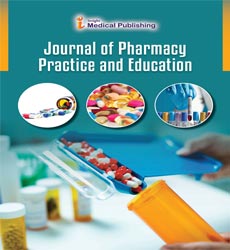N-Acetyl Cysteine (NAC)
Jody L. Green*
Department of Drug poisoning and testing, Vanderbilt University School of Nursing, Nashville, Tennessee, USA
- *Corresponding Author:
- Jody L. Green
Department of Drug poisoning and testing, Vanderbilt University School of Nursing
Nashville, Tennessee
USA
Email: jody.green369@rmpdc.org
Received Date: September 07, 2021; Accepted Date: September 21, 2021; Published Date: September 28, 2021
Citation: Green JL (2021) N-Acetyl Cysteine (NAC). J Pharma Prac Edu Vol.4 No.5: e053
Abstract
Description
Acetyl-cysteine, otherwise called N-acetylcysteine (NAC), is a prescription that is utilized to treat paracetamol (acetaminophen) glut, and to slacken thick bodily fluid in people with on-going bronchopulmonary messes like pneumonia and bronchitis. It tends to be taken intravenously, by mouth, or breathed in as a fog. A few groups use it as a dietary enhancement. Acetylcysteine was at first licensed in 1960 and came into clinical use in 1968. It was listed by WHO under essential medicines. It is accessible as a nonexclusive drug and is cheap. When paracetamol is taken in enormous amounts, a minor metabolite called N-acetyl-p-benzoquinone imine (NAPQI) gathers inside the body. It is typically formed by glutathione, however when taken in overabundance, the body's glutathione holds are not adequate to deactivate the harmful NAPQI. This metabolite is then allowed to respond with key hepatic chemicals, along these lines harming liver cells. This might prompt serious liver harm and even passing by intense liver disappointment. Veins injections and oral details of acetylcysteine are accessible for the treatment of high presence of paracetamol (acetaminophen) in the body. In the treatment of paracetamol (acetaminophen) glut, acetylcysteine acts to keep up with or recharge drained glutathione holds in the liver and upgrade non-harmful digestion of acetaminophen. These activities serve to shield liver cells from NAPQI harmfulness. It is best in forestalling or reducing hepatic injury when controlled inside 8–10 hours after glut. Exploration recommends that the pace of liver harmfulness is around 3% when acetylcysteine is regulated inside 10 hours of excess. Oral acetylcysteine is indistinguishable in bioavailability to cysteine antecedents [1]. Nonetheless, 3% to 6% of individuals given intravenous acetylcysteine show a serious, hypersensitivity like unfavourably susceptible response, which might incorporate outrageous breathing trouble (because of bronchospasm), a diminishing in circulatory strain, rash, angioedema, and in some cases additionally sickness and heaving. Rehashed portions of intravenous acetylcysteine will make these hypersensitive responses logically deteriorate in these individuals. A few investigations have discovered this hypersensitivity like response to happen all the more regularly in individuals given IV acetylcysteine regardless of serum levels of paracetamol not sufficiently high to be considered harmful. Breathed in acetylcysteine has been utilized for mucolytic ("bodily fluid dissolving") treatment notwithstanding different treatments in respiratory conditions with inordinate or potentially thick bodily fluid creation. It is additionally utilized post-operatively, as an analytic guide, and in tracheotomy care [2]. It could be viewed as ineffectual in cystic fibrosis. A 2013 Cochrane audit in cystic fibrosis discovered no proof of advantage. Acetylcysteine is utilized in the treatment of obstructive lung infection as an adjuvant treatment. Proof to help acetylcysteine to forestall radio-contrast prompted kidney illness is blended. Acetylcysteine has been utilized for cyclophosphamide-actuated haemorrhagic cystitis, despite the fact that means is by and large liked because of the capacity of acetylcysteine to reduce the viability of cyclophosphamide. Acetylcysteine has been utilized to complex palladium, to assist it with dissolving in water. This assists with eliminating palladium from medications or antecedents combined by palladium-catalysed coupling responses. N-actelylcysteine can be utilized to ensure the liver. Acetylcysteine can be utilized in Petroff's technique for example liquefaction and disinfecting of sputum, in anticipation of recuperation of mycobacterium [3]. The most regularly announced unfavourable impacts for IV details of acetylcysteine are impulsive, urticaria, and irritation. Up to 18% of patients have been accounted for to encounter hypersensitivity response, which are characterized as rash, hypotension, wheezing, as well as windedness. Lower paces of anaphylactoid responses have been accounted for with more slow paces of imbuement [4]. Unfavorable impacts for inhalational definitions of acetylcysteine incorporate queasiness, retching, stomatitis, fever, rhinorrhoea, sleepiness, moisture, chest snugness, and bronchoconstriction. Albeit rare, bronchospasm has been accounted for to happen capriciously in certain patients. Unfavourable impacts for oral definitions of acetylcysteine have been accounted for to incorporate queasiness, retching, rash, and fever. Despite the fact that N-acetylcysteine forestalled liver harm when taken before liquor, when required four hours after liquor it exacerbated liver harm in a portion subordinate design. Regardless, beneficial outcomes on age-reduced control of breath (the hypoxic ventilatory reaction) have been noticed already in human subjects at more moderate portions.
References
- Buckley NA, Whyte IM, O'Connell DL (1999). Oral or intravenous N-acetylcysteine: Which is the treatment of choice for acetaminophen (paracetamol) poisoning? J Toxicol Clin Toxicol 37(6):759–767.
- Parker D, White JP, Paton D (1990). Safety of late acetylcysteine treatment in paracetamol poisoning. Hum Exp Toxicol 9(1):25–27.
- Kerr F, Dawson A, Whyte IM (2005). The Australasian clinical toxicology investigators collaboration randomized trial of different loading infusion rates of N-acetylcysteine. J Ann Emerg Med 45(4):402–408.
- Appelboam AV, Dargan PI, Knighton J (2002). Fatal anaphylactoid reaction to N-acetylcysteine: caution in patients with asthma. J Emerg Med 19(6):594–595.
Open Access Journals
- Aquaculture & Veterinary Science
- Chemistry & Chemical Sciences
- Clinical Sciences
- Engineering
- General Science
- Genetics & Molecular Biology
- Health Care & Nursing
- Immunology & Microbiology
- Materials Science
- Mathematics & Physics
- Medical Sciences
- Neurology & Psychiatry
- Oncology & Cancer Science
- Pharmaceutical Sciences
